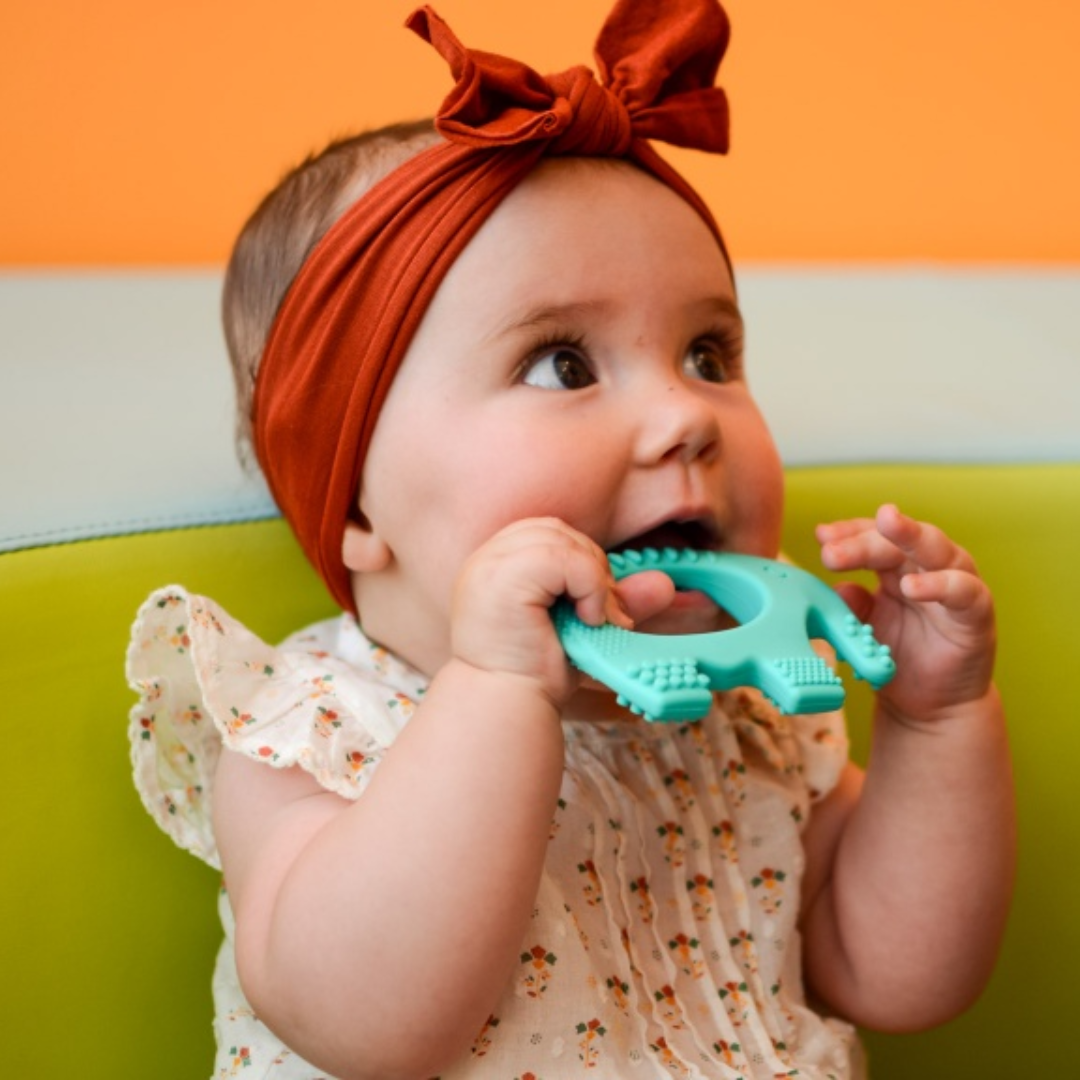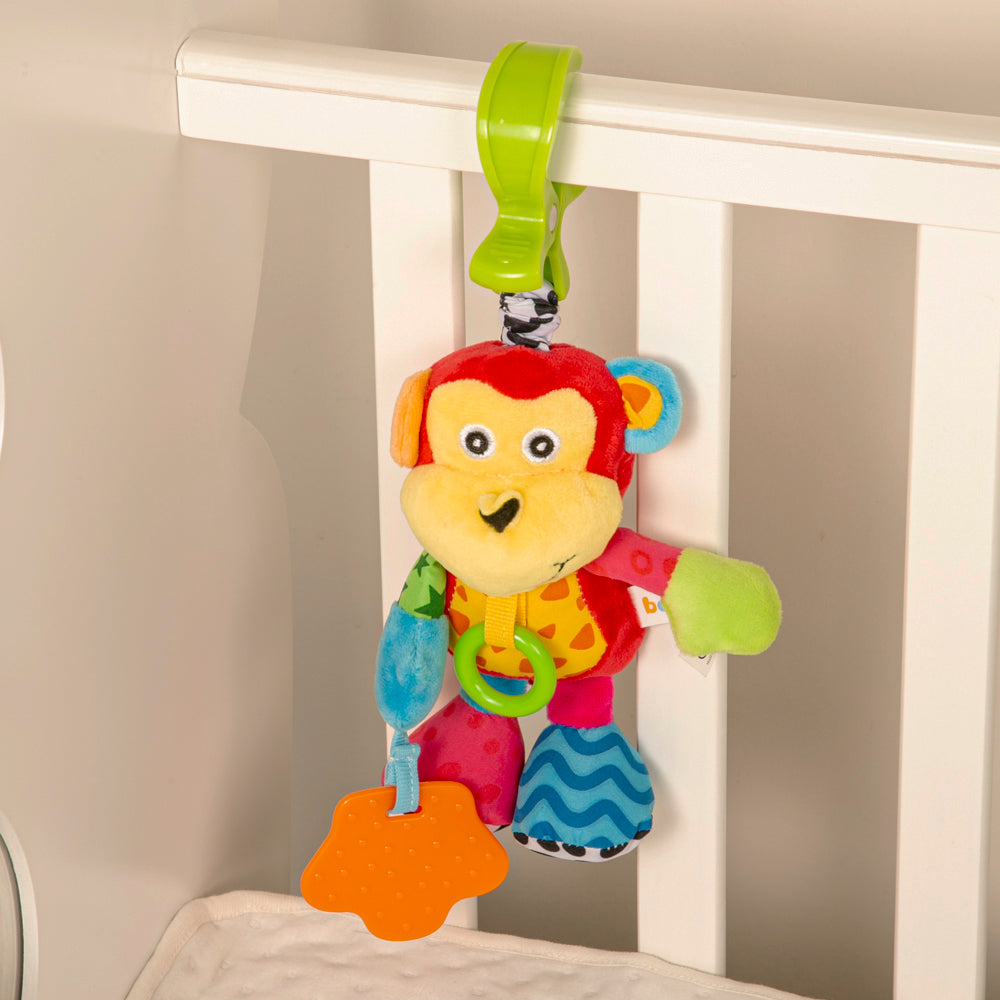
A Guide to Baby Teethers: Choosing the Best for Your Little One
Teething is a milestone that every baby goes through, and while it's an exciting step in their development, it can also be a challenging time for both babies and parents. Teething typically begins around six months of age, though it can happen a little earlier or later. During this period, babies may experience discomfort as their new teeth break through their gums. One of the best ways to help alleviate this discomfort is with a baby teether.
In this blogpost, we’ll explore the different types of baby teethers, their benefits, and tips for choosing the right one for your baby.
What Are Baby Teethers?
Baby teethers are objects that babies can chew on to soothe their sore gums during teething. They are typically made from materials that are safe for babies to put in their mouths. They come in various shapes, sizes, and textures to help massage the gums and provide relief. Teethers can be made of rubber, silicone, wood, or even fabric, and they often feature multiple textures or designs that provide additional sensory stimulation for babies.
Why Are Teethers Important?
When babies start teething, they may experience symptoms such as:
- Irritable mood or fussiness
- Excessive drooling
- Swollen or tender gums
- Chewing on hands, toys, or anything they can get their hands on
- Sleep disruptions
Teething pain occurs because the baby’s new teeth are pushing through the gums, causing inflammation and discomfort. A teether provides a safe and effective way to relieve some of that pressure by allowing the baby to chew on something. The act of chewing helps to massage the gums, which can ease the pain and also promote the eruption of the teeth.
Types of Baby Teethers
There are several types of baby teethers available, each offering different features and benefits. Let’s take a closer look at the most popular ones:
1. Rubber or Silicone Teethers

These are some of the most common types of teethers on the market. Made from soft, flexible materials like rubber or silicone, these teethers are gentle on baby’s gums but durable enough to withstand constant chewing. Silicone teethers are often preferred by parents because they are free from harmful chemicals like BPA, PVC, and phthalates, making them safe for babies.
Pros:
- Soft and soothing on gums
- Easy to clean
- Available in a variety of shapes and sizes
Cons:
- Some may not be as durable as harder materials
- Can be difficult to sterilize thoroughly depending on the design
2. Wooden Teethers
Wooden teethers are a natural alternative to plastic and silicone options. Typically made from non-toxic, untreated wood, these teethers are an eco-friendly option that appeals to parents who prefer natural products. Wooden teethers are often used for their durability and are often combined with silicone or rubber parts to provide added comfort.

Neubaby offers a healthy option made from neem wood by Ariro. Visit our stores today to buy.
Pros:
- Non-toxic and eco-friendly
- Durable and long-lasting
- Typically free of chemicals and dyes
Cons:
- May not be as soft on baby’s gums as rubber or silicone
- Require regular maintenance to keep them clean
3. Cool or Freezable Teethers
Some teethers are designed to be placed in the refrigerator or freezer to provide additional relief. The cold temperature helps to numb the gums and reduce inflammation. These teethers are typically filled with a non-toxic gel or liquid that freezes and stays cold for an extended period of time.

Pros:
- Provides extra relief for sore gums due to the cooling effect
- Easy to use and often very effective
Cons:
- Can get too cold if left in the freezer for too long
- May not be suitable for babies who don’t like the cold sensation
4. Teething Rings
Teething rings are simple, ring-shaped teethers that are easy for babies to grasp. They come in various materials, including plastic, rubber, and silicone. Some teething rings are textured, providing additional sensory stimulation that can help soothe sore gums.

Pros:
- Lightweight and easy for babies to hold
- Often come in fun, colorful designs
- Can be used with or without refrigeration
Cons:
- Some may have small parts that could pose a choking hazard if they break
5. Teething Toys and Accessories
Some teething products go beyond the basic teething ring. There are teethers that combine sensory elements like rattles, plush toys, or even vibrating functions that provide additional comfort for babies. These can be particularly helpful for babies who are also developing their motor skills.

Pros:
- Multi-functional – often combines teething relief with entertainment
- Great for keeping babies engaged
Cons:
- Can be bulkier and harder for younger babies to hold
- May require more cleaning and maintenance
What Type of Baby Teether to Buy?
When shopping for a teether, there are several important factors to keep in mind to ensure you're choosing the right one for your baby’s comfort and safety.
1. Safety First
Make sure the teether is made from non-toxic, baby-safe materials. Look for labels that indicate the teether is free from harmful chemicals like BPA, phthalates, PVC, and lead. It’s also important to check that the teether is properly manufactured and doesn’t contain small parts that could be a choking hazard.
2. Ease of Cleaning
Teething toys can get dirty quickly, so it’s essential to choose a teether that’s easy to clean and sanitize. Many rubber and silicone teethers can be wiped down with soap and water, but some can also be sterilized in boiling water or the dishwasher. Always follow the manufacturer’s cleaning instructions.
3. Comfortable Design
Look for teethers with ergonomic designs that are easy for your baby to hold and manipulate. Textures, ridges, and nubs on the teether can provide additional relief by gently massaging the gums.
4. Durability
Since teethers will undergo a lot of chewing, it’s important to select one that can withstand the constant pressure. High-quality silicone and rubber teethers are often the most durable, but wooden and other natural materials can also be quite sturdy if they are well-made.
5. Multi-Functionality
Some parents prefer teethers that offer multiple uses. For example, teething toys that also serve as rattles or can be chilled for extra comfort may be more versatile and engaging for babies.
Tips for Using Baby Teethers
-
Supervise Your Baby: Always supervise your baby when they’re using a teether to ensure they don’t accidentally break off small parts or bite off pieces that could be a choking hazard.
-
Keep Teethers Clean: Regularly wash and sanitize teethers to avoid any buildup of bacteria. Follow the manufacturer's instructions for proper cleaning methods.
-
Rotate Teethers: If your baby is particularly fussy, it can help to have a few different types of teethers on hand. Babies may prefer one teether over another on different days or depending on how their gums feel.
-
Avoid DIY Teethers: While some parents opt to make their own teethers from household items, it’s best to stick to products specifically designed for teething to ensure safety.
Baby teethers are an essential tool for helping to ease the discomfort that comes with teething. With a variety of options available at Neubaby stores, it’s easy to find a teething toy that suits your baby’s needs and preferences.
By providing your baby with the right teether, you can help make their teething journey a little less painful and a lot more comfortable.
Buy different types of teethers at your nearest Neubaby store today.



